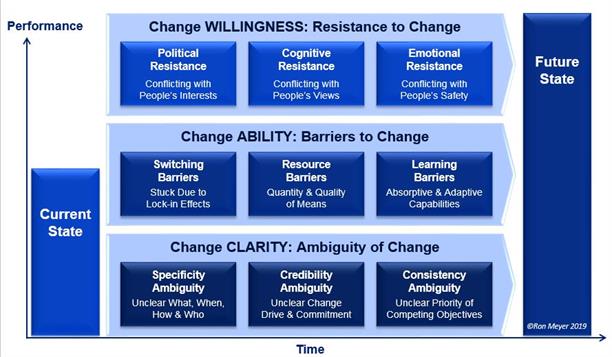Which challenges will you likely face if you try to implement big changes in your organization? TIAS professor of Strategic Leadership Ron Meyer presents an insightful tool to kickstart your thinking: Mind the Gap Model.
Key Definitions
Organizations constantly change, in ways intended and unintended. When managers deliberately intend to alter an organization, shifting it from its current state to a future state, we speak of implementing change.
The challenges involved in successfully implementing change depend on how big the intended change is – whether it is a minor adaptation or a major organizational transformation. Generally, the wider the scope (the number of aspects being changed) and the larger the scale (the extent of the change), the more challenges that will be encountered.
Conceptual Model
The model identifies the three main categories of challenges encountered by managers trying to cross the gap between the current state and the intended future state – hence the tongue-in-cheek name, Mind the Gap Model. Within each of the three categories, three specific challenges are described that are commonly faced when implementing big changes. The model doesn’t suggest that these challenges always occur, but serves as a checklist to warn managers of potential issues they might come up against.

Key Elements
The nine change challenges, grouped into three sets of three, are:
Change clarity. Is it truly clear-cut to all stakeholders what the change entails
Managers often think it is clear what they say, but that doesn’t mean that recipients are clear in their interpretation of what they hear. Common forms of ambiguity among stakeholders are:
A. Specificity ambiguity. Often the change itself hasn’t been made tangible enough to act upon. It is unclear what needs to be done, when, how and by whom.
B. Credibility ambiguity. Changes can also sound too unrealistic to take seriously. It is unclear whether there is sufficient drive and commitment to actually make them happen.
C. Consistency ambiguity. Making changes can also be inconsistent with people’s other priorities. It can then be unclear which objectives people should focus on first.Change ability. Is the organization actually capable of realizing the intended changes? Even if the required change is clear, people might not have the potential to successfully carry out what needs to be done. Common barriers holding the organization back are:
A. Switching barriers. Changes can be frustrated by being locked into such things as long-term contracts, legacy systems and fixed investments, making switching very difficult.
B. Resource barriers. Organizations can also lack the necessary tangible resources, such as money, and/or intangible resources, such as knowledge, skills, relations and mindset.
C. Learning barriers. Organization can also be lacking in their capability to absorb outside knowledge and adaptively figure things out along the way, making learning very difficult.Change willingness. Do all stakeholders actually want to realize the intended changes? Do they embrace the changes put forward and commit themselves to implementing them as intended, or are they reluctant, or even unwilling? Common reasons for resistance are:
A. Political resistance. Going along with the changes might not be in people’s perceived interest. That makes resistance a rational and calculated response to a potential loss.
B. Cognitive resistance. Going along might be against people’s views on what should be done. They resist because they believe the change doesn’t make sense.
C. Emotional resistance. Needing to go along might trigger people’s sense of feeling unsafe. They might fear uncertainty, exclusion or unfairness, leading to resistance.
:quality(90))